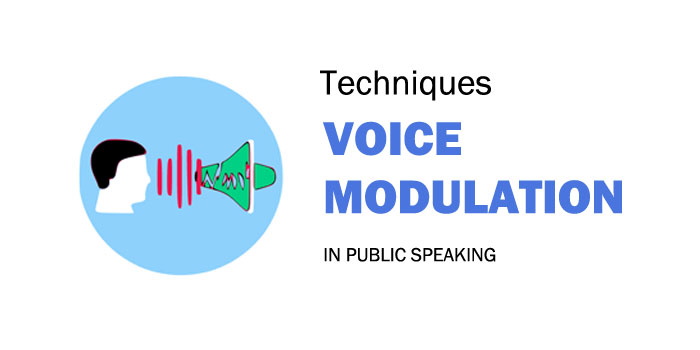Voice Modulation Techniques to Enhance Your Public Speaking
Voice modulation may have gotten a bad rap over the years as something used by some felt puppet characters, but it is a special oratorical tool that, when used properly, can make your speech more powerful and persuasive.
Whether you're introducing yourself in a job interview, delivering a toast at a wedding or simply just trying to improve your public speaking skills, voice modulation is a must-have in your tool box.
In this post we'll show you the techniques necessary to harness the power of voice modulation and turn your ordinary speaking voice into an authoritative, impressive instrument.
We'll cover concepts such as tone, pitch, resonance, diction and timing - all of which are essential for successful vocal control. So if you're looking to boost your speaking game, read on and prepare to be impressed with your vocal enhancements!
Quick Breakdown
Voice modulation is the process of changing the tone and pitch of your voice to convey a desired emotion or emphasis. It is used in many varieties of communication, including speech, singing, and acting.
Benefits of Voice Modulation
Voice modulation is an essential tool that can improve the clarity and strength of one’s speaking voice; when used correctly, it allows speakers to be heard clearly without resorting to shouting or overwhelming their audience with a dull monotone.
Some of the primary benefits of voice modulation include improved communication, better public speaking skills, and increased confidence.
One of the most significant results of using proper voice modulation techniques is improved communication. Not only can changing tones add a unique rhythm and emphasis to the words used in a discussion, but it can also inform the listener as well.
A low-volume soft-spoken tone could signal pain while a higher-volume energetic tone could announce excitement. Voice modulation helps get points across more effectively than mere words ever could, decreasing misunderstandings among speakers and posing a clearer message to their audiences.
Another notable benefit of voice modulation is that it can dramatically improve public speaking skills. When used as part of an effective speech or presentation, various intonations and cadences within the speaker’s otherwise standard volume can capture and keep the listener’s attention.

An invigorated delivery is much more appealing than one steeped in monotony. In addition, when talking about serious topics such as those found in classrooms or corporate settings, appropriate volume and modulation levels can help accurately convey empathy, seriousness, sympathy, passion, etc.; this improves the overall effect of a given speech or presentation.
Finally, using voice modulation during speeches or presentations can increase one’s confidence levels considerably.
Having control over intonation, cadence and volume shifts provides speakers greater authority over their material by providing them with a sense of ownership as they guide listeners through their respective stories. Speaking with confidence works wonders for authenticity while improving the entire atmosphere around discussions.
From improved communication and increased public speaking skills to higher confidence levels – there are many tangible benefits associated with utilizing valid voice modulation techniques in one’s everyday conversations whether they take place in boardrooms or living rooms.
This leads us into our next section which will discuss various methods that can help improve audibility when engaging in these conversations and presentations.
Improve Your Audibility
Improving audibility involves making the voice louder and clearer so that it can be heard from further away. "Projection" or speaking with clarity involves something called diaphragmatic breath control and is an effective way of improving the audibility of your speech without straining your voice.
To start, sit or stand in an upright position with your chest lifted and your shoulders relaxed. Take a slow deep breath as low into the stomach area as possible. This will help to ensure that you have sufficient air to project your voice during a speech.
When speaking remember to keep the mouth open slightly, jaw dropped and tongue relaxed, but still behind the front teeth. If you feel like the volume isn’t coming out then try cupping your hands around your mouth while speaking. In some cases, this can create a resonance chamber around your vocal chords allowing for more sound to come out when speaking.
To speak clearly, focus on pronunciation and articulation. Try enunciating each word by articulating the syllables carefully before moving on to the next word or phrase.
This will help make sure that each word is audible and easy to understand rather than being mumbled, slurred, or swallowed in a sentence. It is also important to construct unintelligible sentences that are well organized and logically built in order to help keep conversations clear, concise and easy to follow.

However, some experts believe that increasing audibility should not be seen as the primary goal of voice modulation techniques. According to these experts, focusing too much on "loudness" can lead to vocal fatigue and poor breathing technique which will ultimately hinder communication rather than supporting it effectively.
It is therefore suggested that individuals should instead look for ways to maintain natural pitch fluctuation within their speech whilst still being loud enough for listeners to hear them clearly.
In summary, improving audibility involves taking mindful steps such as improving breath control and articulation in order improve projection and clarity of speech without straining one's voice. The next section of this article will address how we can use our voices to make a speech more powerful.
Make Your Speech More Powerful
The way you use your voice is an integral part of communicating effectively, and knowing how to make your speech more powerful can significantly improve the impact of your words. Learning to modulate your vocal delivery increases the strength and clarity of what you say. Here are some strategies for turning up the power of your speaking voice.
First, slow down when you talk. People often speak faster than their listeners can comprehend, which saps power from their message. Talking at a slower pace allows you time to emphasize key points and ensure that listeners understand what you're saying.


Additionally, maintain regular pauses between ideas for dramatic effect. These moments of silence draw attention to the importance of what comes next.
Speaking with projection is another important factor in creating a powerful speech. This involves pushing more air through your vocal chords so that your message carries further.
To increase projection, focus on tightening and strengthening the muscles in your face, neck and diaphragm as you speak. Pay attention to volume adjustments as well—too soft and nobody will hear you, too loud and you'll sound aggressive or harsh.
Use pitch variation to create interest while still maintaining a full tone across all inflections. Finally, articulate each word distinctly instead of slurring together phrases; this adds clarity and vividness to your speech in a way that speaks louder than words.
Using the right approach can make all the difference in conveying maximum meaning through spoken communication.
When applied correctly, these techniques for making your speech more powerful will not only bring out the strength of your message but show that you mean business. Now let’s look at some specific techniques for voice modulation that can help amplify your effectiveness as a speaker.
Highlights
To convey maximum meaning through speaking, it is important to use strategies for making your speech more powerful. Such strategies involve slowing down when you talk, using projection, adjusting volume, using pitch variation and articulating each word distinctly. Incorporating these techniques in your speech will emphasize key points and bring out the strength of your message.
Techniques for Voice Modulation
Voice modulation is a critical aspect of successful communication, as it helps to engage an audience and keep them focused. Voice modulation techniques help to vary the levels of pitch, tone and intensity that you use in a conversation or presentation. In addition, learning how to modulate your vocal delivery can also help you sound more confident and dynamic.
It is important to use voice modulation sparingly, so that its effect does not become distracting or annoying to the listener.
Before using any voice modulation techniques, practice them in front of an audience such as friends or family who can give honest feedback about the best ways to effectively use these techniques. Camera recordings are also helpful for evaluating your style and technique.
There are numerous voice modulation techniques that speakers can adopt to change the way their voices sound, including using pauses for emphasis, speaking in various registers, incorporating inflections into sentences, and adjusting the rate of speech depending on the situation.
Some people argue that voice modulation takes away from naturalness, while others believe it can be used effectively to make sure one’s message comes across more clearly and powerfully. Regardless of which view you take, understanding the basics of vocal delivery is essential when giving any form of presentation or talk.



In order to truly master modulation techniques, it helps to learn and practice various exercises that can help you achieve better control and flexibility with your voice. For example, articulating vowels in different directions helps to strengthen your vocal range and ensure a clear delivery. Similarly breath support exercises can increase overall vocal power and control.
The next step in mastering voice modulation is learning how to vary your pitch in order to emphasise certain words or phrases during your presentation or conversation. In the following section we’ll take a closer look at how varying the pitch of your voice can help you become a more effective speaker.
Vary Your Pitch
Varying your pitch is one of the most important voice modulation techniques to consider when trying to improve your speaking voice. There are many benefits to adjusting your pitch in speech, including increasing clarity and engaging listeners.
With strategically varying the pitch of your voice, you can emphasize key points, command attention, and make yourself more memorable as a speaker.
On the other hand, some speakers may be wary of using different pitches because they run the risk of sounding overly theatrical or artificial.


Mannerisms common in exaggerated theatrics can often come across as off-putting or obnoxious when employed in a professional setting. It is thus important to note that proper delivery is paramount when it comes to effectively utilizing this technique.
The key here is to use subtle changes in pitch without coming across as unnatural—that is, practice changing intonation in moderation so your audience can better understand and interpret what you’re saying, but not become too uncomfortable with a sudden shift in tone.
In this way, varying your pitch can be used to convey interest, emotion and authenticity within speech; if implemented correctly it can even help ensure that your message sticks with people long after you've stopped speaking.
By utilizing another essential voice modulation technique—increasing your volume—you can further make sure that your message resonates long after you've finished speaking.
Increase Your Volume
Increasing your volume when speaking is a great way to be heard in different settings and environments. While some individuals have naturally louder speaking voices, it’s something that can be trained and developed to meet different situational needs.
It’s also important to note that there’s a healthy balance between speaking too loudly or not loudly enough.
The most effective technique for increasing your volume is to pause between breaths while speaking instead of talking in one continuous flow. This allows you to speak slowly, allowing more air into each word, giving you a higher and clearer volume.


Additionally, this exercise gives you time to think ahead due to the pauses which will improve your overall clarity and diction.
Another technique for increasing volume is to practice speaking with more passion and enthusiasm. By creating excitement through vocal intensity, it encourages listeners to pay attention and listen more closely.
This technique works well for performers, but it can also help increase the impact in professional settings as well. Soft spoken people in meetings can take advantage of this tactic to ensure their voice is heard.
However, speaking too loudly or intensely can have negative implications such as coming across as aggressive or overly demanding. A person should aim for an assertive tone with just enough vigor, rather than turning up the volume so high that it becomes overwhelming.
By finding the right balance between raising your volume and over-doing it, you can begin developing a more powerful speaking voice. From there, it's recommended learning how to use your voice range properly in order to truly harness the potential of your speaking voice.
- A study published in 2018 found that voice modulation technology was successful in helping reduce stuttering by almost 80% compared to standard speech therapy.
- Research has also shown that voice modulation technology can be beneficial in improving vocal confidence and fluency with 95.8% of users expressing satisfaction with the results.
- According to a study conducted in 2019, it was found that over 95% of people who used voice modulation technology felt more self-confident when speaking to others.
NEXT SECTION:
The next section provides an overview of how understanding your voice range can help you better project your voice and modulate it effectively; let's take a closer look at "Learning Your Voice Range".
Learn Your Voice Range
Learning your voice range is an important step in honing your speaking and communication skills. Knowing the range of tones, volumes, and pitches that you are capable of producing will give you more control in effectively conveying your message.
Understanding what sounds to avoid and which ones draw the most attention will help you create more impactful and persuasive verbal interactions.
It can be helpful to practice focusing on specific sound production exercises in order to become comfortable and expand with different variations of vocal patterns. You may find it useful to use a piano or other musical instrument to highlight where your natural pitch falls within the musical scale.


Practicing your vibrations, volume, pitch, energy, pausing and dynamics can help you reach higher ranges while still maintaining clarity and naturalness in your voice. Tape recordings and video reviews of yourself can also provide helpful feedback on the progress you’re making with learning the various functions of your own personal range.
On the other hand, there is a risk that being too analytic towards reaching a certain sound or tone will affect the naturalness of your delivery.
If a speaker becomes too conscious of their voice they may lose some of its spontaneity as they try too hard to replicate certain techniques they’ve tried to learn without applying them organically within their daily conversations and public speaking events.
The key is finding balance between honing technique while still allowing for an inherent flow to how we express ourselves verbally. To move forward further with this concept, let's explore the bridge technique for better understanding even more about improving the vocal modulations in our voices.
The Bridge Technique
The Bridge Technique is a popular and well-known technique used for improving vocal control and modulation. It involves holding a vibrato without any pitch movement. This technique helps to improve the breath support behind each phrase, as well as expand the range of one’s voice.
Additionally, it works to strengthen the muscles associated with controlling and modulating the voice in order to achieve a better projection and clarity.
On one hand, The Bridge Technique requires the vocalist to carefully monitor their breathing and hold their breath in order to maintain the vibrato. With this technique, wrong notes may be less likely to occur due to the emphasis on correct breathing and control.
On the other hand, incorrect implementation of this technique can lead to strain on your vocal cords and improper vocalization. Therefore, when attempting The Bridge Technique people should practice being mindful of their breathing so that tense singing or straining does not occur.
With proper guidance from a qualified coach, The Bridge Technique can be an effective tool for strengthening both your range of pitch and ability to control your voice. It is important to find teachers that are knowledgeable about using this technique correctly so that it is utilized in an optimal way.
In the next section we will learn helpful tips from voice coaches and experts on how best to use The Bridge Technique to improve one’s speaking voice and vocal modulation techniques.
Tips from Voice Coaches and Experts
Voice coaches and experts often offer invaluable advice to those looking to improve their speaking voice. Among other topics, they often recommend the following techniques:
1. Speak with intent – Before diving into any vocal delivery method, focus on what you are saying—not just how you are saying it. Intention behind speech is key in order to really capture an audience’s attention. Doing this will also help you to clearly articulate your words and modulate your voice.
2. Stretch and warm up – Proper vocal warm-up is essential for optimizing your vocal performance. This includes stretching your head, chest, neck and throat areas. Additionally, experts often suggest a few simple exercises such as “siren sounds” and lip trills to get the voices ready for projection and modulation.
3. Pace yourself – Slowing down when you talk may sound counterintuitive but it can actually be incredibly helpful in terms of speaking with better modulation. Speak at a pace that allows you to take pauses between thoughts, making sure that each sentence is delivered with deliberate expression and intonation.
4. Use pauses effectively – Pause strategically during your speech: taking short breaks can actually boost your confidence and enunciate the message more effectively from a pacing standpoint.
5. Don’t forget facial expressions – Facial expressions can greatly enhance or dilute the quality of speech modulation since they communicate the emotion behind words spoken out loud.


Experts often recommend practicing confident movements in front of a mirror to convey meaning without having to over-emphasize voiced tones or pronunciation of words by relying too heavily on accents or emphasizing certain syllables.
Though not everyone agrees on which technique works best for improving a person's speaking voice, these tips from voice coaches and experts have proven beneficial in helping people access their fullest potential and refine their vocal delivery style allowing them to command attention when speaking out loud.
These tricks all work together and lead into the next key element in working on improving one's voice modulation: practice and consistency. The following section will discuss more about how incorporating practice into one’s routine can further enhance their ability to speak confidently with better modulation techniques for greater impact behind any verbal presentation or conversation.
Practice and Improve Your Voice Modulation
Voice modulation is a core tool for improving a speaker’s voice, allowing them to talk clearly, confidently and understandibly. However, talking well does require some practice in order to master the techniques used for better vocal control.
One useful way to begin practicing voice modulation is to slow down your speech and pick the right words - this helps with clarity and projection of words. Slowing your speech also helps with emphasizing important points or words.
Also important is speaking clearly while maintaining energy and enthusiasm – this will make you more engaging when speaking.
In addition to slowing down one’s speech rate, it is also beneficial to practice various inflections and tones of the voice—softening one’s pitch at certain moments and emphasizing the key words of sentences can really add an extra dimension and depth to one's voice.
There are also exercises which help improve the volume, range and resonance of a speaker's voice, such as humming or singing techniques.
The counter argument to practicing one's modulated speaking might be that it takes too much time or effort and can be difficult for people to do on their own without proper guidance.
However, a good starting point for people who might not have access to professional guidance is free online material such as video tutorials or podcasts from experts in the field, which can help provide easy-to-follow instructions on how to practice voice modulation.
An additional consideration may be that if one practices vocalisations which are not natural then it could lead one to speak in an unauthentic way—this argument carries weight but should not stop people from striving for improvement through active practice.
Ultimately it’s about finding the right balance between sounding genuine but also fashioning oneself into a confident communicator—clearly no small feat!
Practice makes perfect when it comes to using voice modulation techniques appropriately—the more time we put into perfecting our sound, the better results we’ll see in our overall performance as speakers.
Conclusion: Voice Modulation
The techniques discussed in this article can be utilized to successfully improve your speaking voice and make you an effective communicator.
Modulating your voice, as explained above, can help you project authority and confidence, garner both respect and attention from your audience and ultimately make your message more powerful. Moreover, for those with a naturally quiet voice, these techniques can be used to enhance loudness and audibility.
On the flip side, however, it is important to note that over-modulation of one’s voice should be avoided at all costs. This not only gives off a negative vibe but may also sound unnatural and fake if overdone.
Also, while using different accents and tones might add some flair to your speech, it is vital to stay true to one's self and remain authentic. Therefore finding a balance between using the right vocal modulation techniques effectively while staying true to one's self is key in order to get the desired results.
In conclusion, everyone has their own unique voice and ways of speaking which makes them special; there should not be any need to change that by trying overly hard to modulate one’s voice in extreme ways.
However utilizing the correct vocal modulation techniques can undoubtedly help enhance the impact of one's speech, making it more memorable for the listener.
Common Questions Explained
What are some common types of voice modulation?
There are several common types of voice modulation all depending on the situation. For example, if you are speaking in a professional setting, you may want to use a low and even vocal tone that is without exaggerated inflections. This is commonly referred to as “corporate” or “formal” speech.
Another common type of voice modulation is conversational speech, which changes based on the situation. This type of speech is used when someone speaks in a relaxed setting and will often involve varying intonation and natural inflection that reflects their feelings.
People can also modulate their voice depending on their audience. If people are speaking to children, they may want to use higher pitched tones that can help capture the attention of little ones while maintaining enthusiasm throughout the conversation.
Finally, some people choose to modulate their voice when giving a presentation or other public speaking event. This type of voice modulation usually involves speaking a bit slower so that the audience can better understand what is being said and making sure that there are clear pauses for emphasis when running through points.
How can voice modulation be used in communication?
Voice modulation can be a powerful tool in communication, allowing you to convey feelings and sentiments that words alone cannot. When speaking, subtle changes in volume, inflection, pitch, and articulation can add depth and clarity to your speech.
This technique is especially useful when giving presentations or conversations with large groups of people, as it helps keep the audience engaged and more likely to remember the message.
Additionally, voice modulation can help establish relationships by making it easier for both parties to understand each other’s emotions and intentions. Varying your vocal intonation makes it easier to express humor or sarcasm without having to rely on words alone.
Furthermore, being able to control your volume when talking about difficult topics can make the conversation more bearable for both parties.
All in all, voice modulation is an important skill in communication as it allows us to be more expressive and better understood by our listeners.
How does voice modulation work?
Voice modulation is the art of controlling and altering your vocal sound in order to best communicate your feelings and intentions. It's a powerful tool that can help you create stronger connections with others, be more persuasive and command attention.
Voice modulation allows you to control the volume and pitch of your voice, so you can better express yourself.
Using vocal dynamics, such as volume and pitch, can effectively add emphasis to certain words or phrases. For example, raising the volume when you make an important point will draw the listener’s attention and emphasize its importance.
Lowering your pitch for a more calming effect can also keep listeners engaged. By adding pauses and silences at strategic points in your speech, you also lend emphasis to certain words or sentences.
Additionally, conversational pacing (not speaking too fast or slow) promotes good communication between both parties and helps build trust between individuals. In this way, voice modulation plays an essential role in connecting with people and conveying your thoughts and feelings in a meaningful way.
